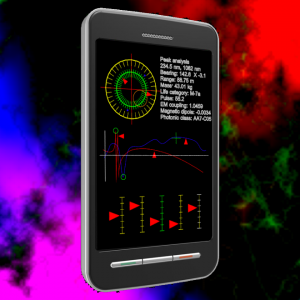2013
Apr
27
Of Cell Phones and Tricorders
But nothing of cabbages and kings.
Having been a certifiable geek since 1959, perhaps earlier, I was, naturally, a fan of the original Star Trek series when it debuted in 1966. It was unavoidable. The binding that occurred led to dreams, of course. A great many of them involved phasers in some way or another, but in the real world, I was much more fascinated with tricorders.
This is not surprising because, you see, in the alternate reality of adolescent fantasy, I was Mr. Spock. My best friend, Jim, was Captain Kirk (quite logical, because they have the same first names) and Mike, I believe, was Scotty. That's OK; I didn't want to be the captain, anyway; I was more the science officer type. In moments of terminal geekdom, I would walk around with my hands clasped behind my back, raising my eyebrows, and quoting, "Fascinating." That was an identity crisis from which I did eventually recover.
Being a hopeless Spock-like geek with knowledge of electronics, it was probably also unavoidable that I would eventually want to build a real tricorder. I am not the only person with that fantasy (click here) but I was probably one of the very few in the late '60s, at a time before there were LCD displays, large-scale integration, lithium-ion batteries, or even (gasp!) commercially available microprocessors. Still, I thought I could have packed a crude UV-vis-near-IR spectrometer, RF analyzer, magnetometer, bolometer, and a few other instruments into a usable package. I even bought some parts, but I didn't get very far with it because, as a high-school student, I was flat broke most of the time.
But what's all this have to do with cell phones?
It started with a vision. If you are a writer, you know what I mean: that moment when some brief image pops into your head,
one that has the potential to develop into a story. You know the kind: it grabs you and pulls your imagination along for a while just to see where it goes. This particular vision was of a young girl on a city street, scanning around with her cell phone, and reporting back to someone, "I think I've found him." That image might become another entry here, but for now, it led me to think about the similarity between modern cell phones and tricorders.
A typical smart phone is loaded with quite an array of sensors. Mine isn't even particularly fancy, but it has these:
-
Two-dimensional visual imager
Non-geeks will simply call this a camera, Nevertheless, a two-dimensional visual imager is exactly what it is. Unfortunately, the camera won't work as a visible-light spectrometer, but if you knew you were looking at a monochromatic laser light source, an app could exist, properly calibrated, to measure its wavelength. Also, your camera gives your phone the ability to scan QR codes for whatever purpose floats your boat.
-
Audio sampler
Again, non-geeks would call this a microphone, and an obviously necessary sensor for a phone, or you wouldn't be able to talk to anyone. But it could go beyond that. Engineer that I am (yes, I'm still a chemist, too), I knew that it would be possible to write a spectrum analyzer app, and in the process of writing this entry, I searched to see what is out there already, and indeed there are several. Here's one for Android. Curiously, an audio spectrum analyzer is one function that it never occurred to me to put into my 1969 "tricorder."
-
GPS terminal
The GPS in your phone is actually an array of multiple high-frequency electromagnetic sensors. After all, you need at least four satellites to know where you are. The best I could have done with mine was to determine which way was north. See below.
-
Magnetometer
GPS will tell you where you are, but it won't tell which way you are facing. Enter the magnetometer, which measures the earth's magnetic field to determine direction. Of course, magnetic north isn't exactly true north, but not to worry. Since the GPS determines location, a smart enough phone can look up the declination (difference between the two) and calculate where true north is. I don't know if mine's that smart; it just needs the right app. On the downside, my magnetometer keeps provoking "Anomalous magnetic field" messages, probably more common if you spend your time in science labs.
-
Gravimeter/accelerometer
These are pretty much the same thing. A gravimeter is a specialized accelerometer designed to measure the acceleration of gravity. In other words, it can tell which way is up. Or, more specifically, down. It can also tell when you are shaking the phone, but except for games, I'm not sure what good that information is. This is the part that figures out how you are holding the phone so that it knows which way to display the image.
These three (GPS, magnetometer, and accelerometer) tell the phone not only where it is in three-dimensional space, but which way it is facing. This opens up a whole category of interesting possibilities, from those rolling-ball-in-the-maze puzzles to using it as a crude level while you're building your house. What I like it for (being a geek, of course) is the SkEye app. Point it in any direction and it will show you what you would see in space if the earth weren't in the way. Not as cool as a real telescope, but a great geek toy, and a telescope can't see through the earth.
So, it would seem that in the intervening 44 years, while I was asleep, I guess, much of my fantasy has been realized. There are no UV-Vis-infrared spectrometers in phones yet, but how long before there are? How soon will be we able to detect life-forms hiding behind boulders or detect phasers on overload or anomalous neutrino fluxes? "Still science fiction," you say? Maybe not so much. OK, detecting neutrino fluxes will be sci-fi for a while.
A brief escapade with Google has shown me that already you can buy an attachment that contains chemical, temperature, infrared, humidity, and proximity sensors. Cell phone technology is being investigated to locate snipers and record environmental data. The tricorder of my youthful Star Trek fantasies is just around the corner.
So, it appears, is Big Brother.
















Comments
There are no comments for this post.
You must be logged in to post a comment.